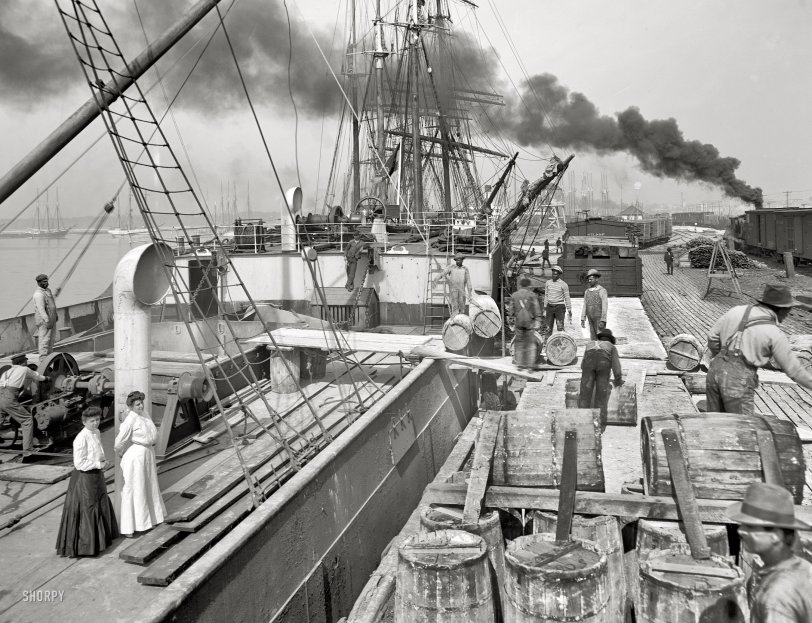


Framed or unframed, desk size to sofa size, printed by us in Arizona and Alabama since 2007. Explore now.
Shorpy is funded by you. Patreon contributors get an ad-free experience.
Learn more.

- Freeze Frame
- Texas Flyer wanted
- Just a Year Too Soon
- WWII -- Replacing men with women at the railroad crossing.
- Yes, Icing
- You kids drive me nuts!
- NOT An Easy Job
- I wonder
- Just add window boxes
- Icing Platform?
- Indiana Harbor Belt abides
- Freezing haze
- Corrections (for those who care)
- C&NW at Nelson
- Fallen Flags
- A dangerous job made worse
- Water Stop
- Passenger trains have right of way over freights?
- Coal
- Never ceases to amaze me.
- Still chuggin' (in model form)
- Great shot
- Westerly Breeze
- For the men, a trapeze
- Tickled
- Sense of loneliness ...
- 2 cents
- Charm City
- What an Outrage
- Brighton Park
Print Emporium
Gulfport: 1906

Gulfport, Mississippi, circa 1906. "Steamer loading resin." 8x10 inch dry plate glass negative, Detroit Publishing Company. View full size.
Flag Astern
Sorry for the late comment, I had medical issues in 2014 and missed most everything.
The flag is that of the Austro-Hungarian Empire, the "merchant flag" to be exact.

Rigging
I don’t know anything about ships, propellers and the machinery in this photo. However, I may be able to add something about the ladies. They look middle class to me, they are not in working clothes. Their skirts are well pressed without too many creases. Perhaps wives of officers? They look to be aged late 30s or 40s. They are both wearing straight front corsets. They look not to be very tight, the wasp waist had passed out of fashion 8 years ago. These two would probably have worn tighter, stiffer and longer corsets for best wear. At this time the corset did not reach the bust, so the breast sagged. It was about this time that the bra made its first appearance in fashionable circles, and probably these two were unaware of it in 1906.
My only comment is that they are not wearing hats. At this time hats were BIG and an essential part of a woman's costume.
Modishly buxom
The pigeon-breast, S-curve silhouette was the fashion. It's likely that lady has some combination of corset and padding to create that monobosom. As weird as it looks to our eyes now, she'd have been considered the more stylish of the two ladies at the time!
Sun
Would that be the Sun low in the background? Through a haze?
[No. As we can see from the shadows on the ship, the sun is high in the sky. - Dave]

Ventilated box car
The boxcar with the "slatted door' is a ventilated boxcar. On the Atlantic Coast Line they were known a "watermelon" cars because that's what was shipped in them.
A bra! A bra!
My kingdom for a bra. I mean really, all the unmentionables available back then and they had yet to wrap some things up properly.
Another Screw.
So may great details as per usual in a photograph from Dave!
Note the spare propeller bolted to the deck behind the hatch and amidship betwixt the two steering chains.
If a propeller was lost or damaged en route, it was cheaper and quicker to carry a spare than have one made, then shipped on another steamer possibly several thousand miles to some distant port.
As mentioned previously, whose flag IS flying astern?
Note the box car to the right has an inner slatted door for ventilation, above which are the trolley wire support brackets on the poles for an electric railway.
Thank You.
Wow!
Marjorie Main was older than I thought.
Ya gots to feel sorry for him
I'm talking about the poor guy over on the back right of this picture (part of a trio) having to wear the polka dotted calico overalls that were obviously home-made by his wife from flour sacks or feed bags and styled like an apron. I'm pretty sure he was razzed by the other stevedores for not fitting into the image of "rugged" that they portray.
Mabel, get out the washboard!
Seeing those ladies in their crisp white linen under the smokestack soot is making me cringe!!
A sticky profession
Although this photo was taken before my town came to be, the sight of those barrels of raw pine tar are familiar to us here in Portal, GA, a tiny town which holds an annual Turpentine Festival and which lays claim to one of the only still functioning original stills from the 30's-40's. The still is fired up each year and turpentine made and sold in Mason jars and glass jugs to the community. Although the practice of harvesting pine resin died out in the 60's in our area, almost anyone who has spent time in the woods here can attest to finding pine trees with the "catfaces" still present, which is what they called the V-shaped scars from the slash marks made to collect the tar from trees. The tar is extremely flammable and care must be used at the still site around the furnace underneath the vat, lest the whole structure go up in flames.
Passengers, too?
This one's loaded with great maritime details, but the two ladies in the left foreground are a mystery. Could the ship be carrying passengers? It seems unlikely because the "resin" being loaded is evidently a really messy substance (perhaps the sap from pine trees, used in glue and some kinds of paint? There were/are plenty of pine trees in Mississippi.)
The man in the left middle might be working the steam winch. His knee is close to the cylinder that's doing the driving, and another drum like the one on the right is doubtless taking the tail of the tackle that's passing behind the black man standing at the left to take the weight of the two barrels being swung on board on the right. It seems that the longshoremen at Gulfport in the period were all black, but the man working the winch might not be (hard to tell since he's facing away from the camera).
We are looking aft at the quarterdeck of the ship. This is shown by the emergency steering wheel and stern staff with flag. The ship is not US flag, possibly from one of the South or Central American countries? The chain entering the boxy fitting next to the lounging man at the break of the quarterdeck is almost certainly a steering gear linkage from the main steering station on the bridge; note there is a second, identical one on the other side of the ship. Mechanical steering linkages were common on steamships of the period. The emergency wheel would be geared direct to the rudder head in case one of the chains parted or something on the bridge let go.
Note the sailing ships tied up astern of the ship in the foreground, a 3-masted schooner on the left and a square rigger, possibly a bark, on the right. It is a little surprising to see a deep water square rigger on the Gulf Coast as late as 1906, but schooners were very common and several are shown in the distance.
She's checking him out.
"Arlene, quit looking at the camera & check out the butt on the guy standing by the barrels."
Are those women
Resin ladies or plank inspectors?
Rails to the Gulf
The 0-6-0 in this photograph is owned by the Gulf & Ship Island Railroad, which ran from Gulfport to Jackson with several branches in Southern Mississippi. The G&SI was a long-term project, check out this link for more information on the scrappy little line. They were taken over by the Illinois Central in 1925. Visit this link for a route map and more information on the G&SI. http://www.msrailroads.com/G&SI.htm
As a Mississippian, I'm thrilled to see our State Port before it became a facility of concrete, bananas, and TEUs.
Farked?
The ladies seem so obviously out of place, the photo appears to be pre-farked.
Languid personified
The two ladies, who one assumes were wives of the officers, seem totally disinterested in what's going on around them. No doubt they have seen it all before but you would think they could have made an effort for the photographer.
























On Shorpy:
Today’s Top 5